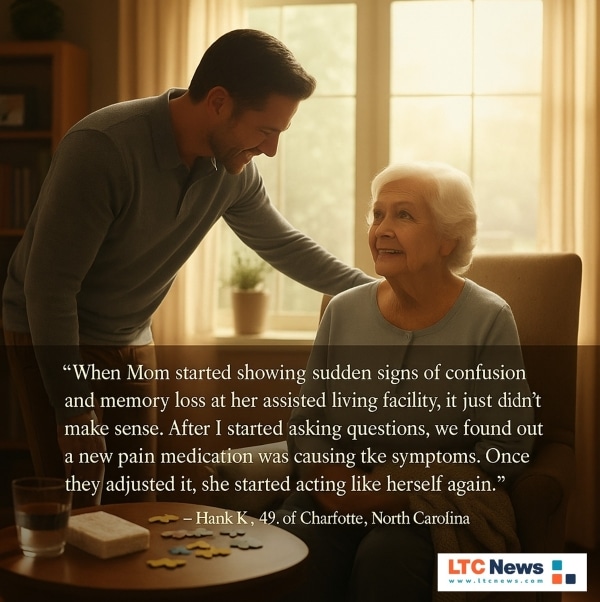Opioid Misuse Often Overlooked in Long-Term Care Settings

Table of Contents
Walk into a nursing home or assisted living facility at medication time, and you’ll notice the rhythm—small paper cups, measured doses, nurses moving from room to room like clockwork. It feels safe and predictable. Residents and their loved ones trust that relief is coming, families trust the system, and staff follow routines built to maintain order.
But beneath that routine lies a quiet dilemma. Pain rarely follows a schedule, and neither do opioids. These medications bring undeniable relief, but in long-term care settings, they can also bring dependence—and that danger often goes unnoticed until it’s already changed someone’s quality of life.
Why Opioids Are Common in Long-Term Care
Pain is one of the top reasons residents receive medications in nursing homes. According to a report from the U.S. Department of Health and Human Services’ Office of the Assistant Secretary for Planning and Evaluation (ASPE), opioids are frequently prescribed when other pain-relief methods fall short.
Opioids make sense for severe pain after hip surgery, cancer treatments, or advanced arthritis. For time-strapped nursing staff, they’re quick to administer and are reliably effective.
Yet that convenience comes with a cost. The same potency that provides comfort also creates risk—especially when temporary use quietly stretches into a long-term habit. In an environment built on routines, it’s easy for “as needed” to become “every day.”
Opioids continue to be a reasonable option for frail older adults with multiple chronic conditions and opioids should be available to this patient population as clinicians develop treatment plans for managing their persistent pain. — American Geriatrics Society’s comments on the CDC opioid guideline.
The Subtle Signs Families Overlook
Opioid dependence in older adults doesn’t usually resemble the addiction headlines you see in the news. It’s slower, quieter, and harder to recognize.
Common signs include:
- Persistent drowsiness or mental fog
- Memory lapses or confusion
- Increased irritability or mood swings
- Unsteady walking or more frequent falls
These symptoms can resemble “normal aging,” making the issue easy to overlook. Even trained staff may overlook early signs of dependence because they mimic natural decline. That’s what makes opioid misuse in long-term care so insidious: it hides behind the ordinary.
Experts say that families often assume a new grogginess or confusion is just part of aging, but it may be the medication, not the person.
The Harsh Reality of Dependence
The body adjusts to opioids quickly. Dependence can develop in just a few weeks. If the medication is reduced too fast or stopped abruptly, withdrawal symptoms appear—sometimes within hours.
According to Pinnacle Treatment Centers, opioid withdrawal symptoms can include:
- Restlessness, chills, and sweating
- Nausea or vomiting
- Anxiety and irritability
- Dangerous blood pressure spikes in frail patients
For residents of long-term care facilities who already struggle with chronic conditions, withdrawal can be not only miserable but medically risky. That’s why tapering and close medical supervision are essential when reducing opioid use.
Experts say a doctor can’t simply stop opioids cold turkey in a long-term care setting since you would be replacing one crisis with another if withdrawal isn’t managed correctly.
Safer Pain Management Strategies
Fortunately, opioids aren’t the only way to manage chronic pain in long-term care. Several non-opioid and holistic approaches can help residents find comfort without risking dependency.
Non-Opioid Medications
- Acetaminophen (Tylenol): Effective for mild to moderate pain, though it must be used cautiously in patients with liver conditions.
- NSAIDs (Nonsteroidal Anti-Inflammatory Drugs): These meds, such as ibuprofen or naproxen, are helpful for inflammation-based pain like arthritis.
- Adjuvant Medications: Certain antidepressants or anticonvulsants can target nerve pain without opioid effects.
Therapy and Movement
- Physical therapy rebuilds mobility and reduces pain over time.
- Occupational therapy focuses on improving daily functioning safely.
- Gentle exercises, such as yoga or tai chi, can strengthen muscles and improve mood.
Holistic and Behavioral Approaches
- Mindfulness or meditation reduces pain perception and anxiety.
- Heat and cold therapy offer localized relief.
- Cognitive behavioral therapy (CBT) helps residents manage chronic pain through thought and behavior patterns.
Pain Management Method Relief Speed Dependency Risk
Managing chronic pain for someone living in a long-term care facility or living at home with caregivers requires a careful balance between comfort and caution. While opioids can provide rapid pain relief, their potential for dependency makes them a last resort for many healthcare professionals.
The table below compares the speed and risks of common pain-management approaches used in long-term care facilities.
| Pain Management Method | Relief Speed | Dependency Risk |
| Opioids | Fast, strong | High |
| Non-opioid medication | Moderate | Low |
| Therapy and exercise | Gradual | Very low |
What Families Can Do
As a family member, you play a crucial role in identifying issues that staff might overlook. Don’t assume every new symptom is “just aging.” Ask questions and advocate for your loved one’s care plan.
Start with these:
- How long has my loved one been taking this opioid?
- Is there a reassessment schedule for dosage and necessity?
- Are there non-opioid or complementary options available?
- Could a medication review by a geriatric pharmacist help?
Families who ask these questions often help identify overmedication early—sometimes before dependency develops.

You can also use the LTC News Caregiver Directory to find specialized care facilities or providers experienced in managing chronic pain safely and effectively.
If your loved one has a Long-Term Care Insurance policy, be sure to tell the admissions director they have a policy. Get free help in processing the claim. LTC News partners with Amada Senior Care to provide free claim support with no cost or obligation — File a Long-Term Care Insurance Claim.
Why This Risk Deserves More Attention
Opioid misuse in long-term care doesn’t usually make headlines. It’s not about overdoses—it’s about slow declines in independence, awareness, and personality.
The Centers for Disease Control and Prevention (CDC) has warned that older adults face higher risks from prescription opioids due to slower metabolism and polypharmacy interactions. These risks can lead to:
- Falls and fractures
- Cognitive decline
- Reduced social engagement
- Diminished quality of life
Pain relief should never come at the expense of dignity or safety. Families and care teams must find balance—comfort without compromise.
Final Thoughts: Comfort Without the Cost
Opioids are powerful allies in pain control when used correctly. The goal isn’t to eliminate them—it’s to use them wisely.
You don’t need to micromanage every pill, but you do need to stay aware. Look for subtle changes, ask questions, and insist on reviews. Real care goes beyond comfort—it preserves the person’s well-being, independence, and dignity.
Before assuming “this is just part of aging,” ask: Could it be the medication instead? That single question can change the course of care.


